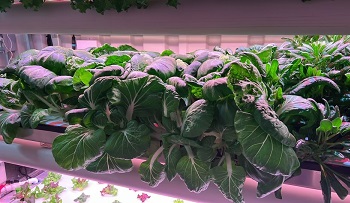
Despite approximately 80 per cent of Canadian farmland being located in the Prairies, where vast acres of wheat, canola, lentils and other grains and oilseeds grow in abundance, there are a significant number of communities experiencing food insecurity. Waterhen Lake First Nation was one of them.
Located north and partway between the more well-known cities of Edmonton, Alberta, and Prince Albert, Saskatchewan, Waterhen Lake is not located on a major highway. While they do have road access to larger grocery stores 50 kilometres away, it is challenging and costly for the community members, especially those without access to vehicles, to get fresh produce regularly. And when they do get fresh produce like lettuce or other leafy greens, it has travelled many days from its source and is often worse for wear.
The community’s goal was to increase food security for vulnerable groups such as the elderly, those using social assistance programs, people with special health needs and the kids at school. Given the environment, hydroponics seemed like the best choice. However, large-scale hydroponic operations are expensive and require specific skills to manage.
Fortunately, a project in Altario, Alberta provided a model for their success. Kevin Van Lagen, principal at the local school, was there in 2017 when the school started a student-led farm. With a goal of sustainability and education, they raise poultry, bees, laying hens, steers and pigs. They also have a hydroponic operation funded through Agriculture and Agri-Food Canada’s Local Food Infrastructure Fund (LFIF).
Kevin understood the hands-on learning value this school project provided and that many First Nations were struggling with food security, so those communities were invited to see the Altario farm in action.
Waternhen Lake First Nation expressed interest in food security and sought more information about the program.
Since it first launched in August 2019, LFIF has committed $65 million to support over 1,100 projects to improve food security across Canada, such as: community gardens and kitchens; refrigerated trucks and storage units for donated food; greenhouses in remote and Northern communities; and more. It was created as part of the Government of Canada's Food Policy for Canada, which aims to build a healthier and more sustainable food system in Canada. That is why Budget 2024 included $62.9 million over three years, starting in 2024-2025, for Agriculture and Agri-Food Canada to renew and expand LFIF and invest in local food infrastructure.
LFIF provided funding to Waterhen Lake First Nation to purchase a 10 foot by 40 foot compartmentalized hydroponic growing system.
“I didn’t realize how much this project would impact the community,” says Kevin. “The quality of produce is unbelievable – people can have a salad that was harvested that morning, and what they don’t eat will last for four weeks because it doesn’t lose time being trucked in.”
Kevin also notes the aftercare of these projects is very important for their success. “Understanding how these projects fit into the communities, how to manage them and even how to make this greenery palatable to a group not used to cooking with them is key.”
Waterhen Lake First Nation now serves 50-100 people per week and has made several partnerships within the community, which have provided educational opportunities, bridged generational gaps and encouraged healthier eating.
“The success of that first LFIF hydroponic operation at the Altario school led to the development of the project at Waterhen Lake,” says Kevin. “It has been a pleasure to be part of both and wonderful to see them succeed – both from a quality education perspective and for food security.”
Learn more about the Local Food Infrastructure Fund.
Get more Agri-info
- Want more stories like this? Explore what else Agri-info has to offer.
- Interested in reporting on this story? Contact AAFC Media Relations at aafc.mediarelations-relationsmedias.aac@agr.gc.ca to arrange an interview with one of our experts.